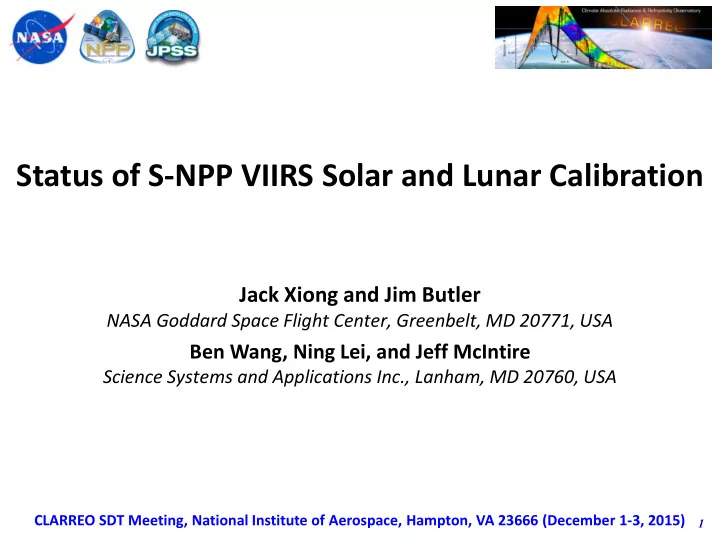

Status of S-NPP VIIRS Solar and Lunar Calibration Jack Xiong and Jim Butler NASA Goddard Space Flight Center, Greenbelt, MD 20771, USA Ben Wang, Ning Lei, and Jeff McIntire Science Systems and Applications Inc., Lanham, MD 20760, USA CLARREO SDT Meeting, National Institute of Aerospace, Hampton, VA 23666 (December 1-3, 2015) 1
Outline • Solar and Lunar Calibration – Strategies and Activities – Methodologies • Performance Updates – On-orbit Changes and Performance Updates (Improvements) – Comparison of Solar and Lunar Calibration • Future Efforts • Summary 2
Solar and Lunar Calibration Strategies and Activities 15 RSB: M1-M11, I1-I3, DNB H/L gains: M1-5 and M7 l : 0.4-2.3 m m Solar Diffuser Stability Monitor SD with a fixed screen SD calibration each orbit Daily operation => 3 per week (8 min => 5 min) Future reduction of frequency and operation time 8-9 / year SC roll maneuver Same phase angle Rotating Telescope Assembly (RTA) 3 Extended SV Port
Solar Calibration Methodologies Quadratic Approach RVS 2 VIIRS Radiance (L) Retrieval: L F L F c c dn c dn PL 0 1 2 F : Calibration scaling factor derived from on-orbit calibration c i : Pre-launch calibration coefficients (quadratic algorithm) RVS : Sensor response versus scan-angle Reflectance Based L SUN VIIRS Solar Calibration: F L E BRDF ( t ) cos SD L SUN SUN SDS inc SD , PL L SUN : Expected solar radiance reflected from SD panel L SD,PL : Retrieved solar radiance using pre-launch calibration coefficients SD Degradation (H): BRDF(t) H (t) BRDF(t ) Norm 0 4
Lunar Calibration Methodologies I I ROLO ROLO F VIIRS Lunar Calibration: MOON I L g / N MOON , PL MOON , PL B SCAN det, sam , scan I ROLO : Lunar irradiance (integrated) provided by ROLO model I MOON,PL : Lunar irradiance retrieved using pre-launch calibration coefficients N SCAN , B , g: number of scans, pixel solid angle, aggregation factor Ongoing and Future Activities for Lunar Model Improvements: • USGS ROLO (Stone/Kieffer) • NIST high accuracy measurements (Brown et al) • CNES POLO data 5
On-orbit Changes and Updates (Improvements) • SD and SDSM Screen Transmission – Pre-launch characterization – On-orbit yaw maneuvers – Yaw + regular on-orbit data • Correction for Solar Vector Error – Consistently reprocessed SDR for NASA science research community – Different impact for VIS/NIR and SWIR • Modulated RSR (relative spectral response) – Due to strong wavelength-dependent optics degradation – Different impact for solar and lunar calibration, and EV data – Large effect for DNB (broad bandwidth: 500-900 nm) calibration 6
SD and SDSM Screen Transmission (LUTs) SDSM PL_LUT H D H SDSM Yaw_LUT SDSM New_LUT Improved H => better quality of F Similar improvements to SD screen transmission 0.41, 0.48, 0.67, 0.86 m m 7
SD and SDSM Screen Transmission (LUTs) Impact on F-factor (1/Gain) 0.45 m m, 0.87 m m, 1.38 m m 8
Correction for Solar Vector Error in SDR Geo Library • A mismatch of ECI (Earth-Centered Inertial) frames when computing the transformation to spacecraft frame library leads to ~0.2 ⁰ error in the solar angles used in the RSB radiometric calibration. • Different impact for VIS/NIR and SWIR bands Δ F VISNIR Δ H Δ F SWIR • The cos θ SD SD factor is used in both H- and F-factor calculations. 9
SD F-factors for VIIRS Reflective Solar Bands M1 0.41 M2 0.45 M3 0.49 M4 0.56 I1 0.64 M5 0.67 M6 0.75 I2 0.87 M7 0.87 M8 1.24 M9 1.38 I3 1.61 M10 1.61 M11 2.25 10
Solar Diffuser and Optics Degradation SD degradation: First 3.5 years Large at short wavelength Optics degradation: Large at NIR/SWIR 11
Development and Update of On-orbit Modulated RSR Time-dependent RSR Large impact on DNB with a broad bandwidth Small impact on bands with narrow bandwidths and non-negligible OOB responses 12
SD F-factors for VIIRS Reflective Solar Bands M1 0.41 M2 0.45 M3 0.49 M4 0.56 I1 0.64 M5 0.67 M6 0.75 I2 0.87 M7 0.87 M8 1.24 M9 1.38 I3 1.61 M10 1.61 M11 2.25 13
SD and Lunar F-factors for VIIRS Reflective Solar Bands M1 0.41 M2 0.45 M3 0.49 Lines: SD M4 0.56 Symbols: Moon I1 0.64 M5 0.67 M6 0.75 I2 0.87 M7 0.87 M8 1.24 M9 1.38 I3 1.61 M10 1.61 M11 2.25 14
Future Efforts • Combine SD and Lunar Calibration for Improved SDR LUTs – SD and lunar observations are made at the same AOI – Remove potential impact due to SD degradation (SDSM and SD degradation uniformity) • Use Lunar Observations to and Characterize and Reduce Detector to Detector Calibration Differences – Similar strategy developed and applied for MODIS calibration – Small differences in a few VIIRS spectral bands • Improve Lunar Calibration – Absolute - effort by NIST/USGS (goal: 0.5%) and by GSICS/USGS (goal: 2%) – Relative - response trending and calibration inter-comparison 15
Detector to Detector Calibration Differences 16
Approaches for Lunar Calibration Improvements With an empirical libration correction Impact due to lunar phase angles Phase angle dependence of the ROLO model (blue bands) Pleiades: POLO 17
Summary • S-NPP VIIRS continues to perform well, meeting the need for operational users (SDRs/EDRs from IDPS) and science community (reprocessed SDRs/EDRs) – NASA VCST and SIPS effort – NOAA reprocessing plan • Improved understanding of both solar and lunar calibration led to generation of consistent LUTs and high-quality data product s • Future efforts planned to address various challenging issues – Near-term – Long-term 18
Recommend
More recommend